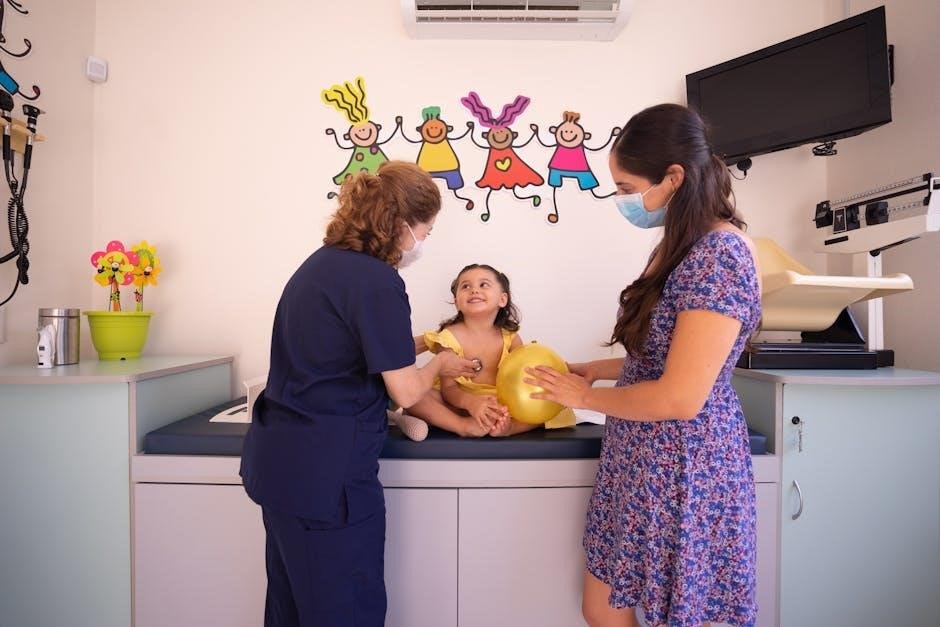The NBME Family Medicine Shelf Exam assesses clinical knowledge in family medicine, focusing on preventive care, chronic disease management, and common conditions. Utilizing resources like First Aid for Family Medicine and UWorld questions is crucial for success.
1.1 Overview of the Exam Format and Content
The NBME Family Medicine Shelf Exam consists of multiple-choice questions assessing clinical knowledge. It includes topics like preventive care, chronic disease management, and common conditions. The exam format typically involves 50-100 questions, with a focus on applying knowledge to real-life clinical scenarios.
1.2 Importance of the Exam in Medical School Curriculum
The NBME Family Medicine Shelf Exam is crucial for assessing clinical competence in family medicine. It evaluates students’ ability to apply knowledge in real-world scenarios, making it a key component of medical school curriculum and clerkship evaluation. High scores reflect strong clinical reasoning and preparedness for residency.

Study Strategies for Success
A structured study plan, integrating First Aid for Family Medicine for high-yield topics and UWorld questions for clinical application, is essential. Regular timed practice exams and organized review of weak areas ensure comprehensive preparation.
2.1 Effective Use of First Aid for Family Medicine
First Aid for Family Medicine is a high-yield review guide focused on key topics and clinical scenarios. It emphasizes preventive care, chronic disease management, and common conditions, making it an essential resource. Use it to identify and master critical concepts, then supplement with UWorld for clinical application and practice exams.
UWorld questions are a cornerstone of NBME Family Medicine Shelf Exam prep. They offer realistic clinical scenarios and test-taking simulations. Pairing them with First Aid for Family Medicine ensures a balanced approach, combining high-yield facts with practical application, enhancing both knowledge and exam readiness effectively. A well-structured study schedule is vital for NBME Family Medicine Shelf Exam success. Allocate dedicated blocks for high-yield topics, practice questions, and review. Consistency is key; aim for regular study sessions and incorporate First Aid and UWorld for a balanced approach. Regular practice exams help refine pacing and endurance. Essential resources include First Aid for Family Medicine, UWorld questions, and PDF guides like the Diabetes Medical Specialties sample questions. These materials provide high-yield content and practice exams. First Aid for Family Medicine is a top choice, offering concise, high-yield content. Master the Boards and Step-Up to Family Medicine are also recommended for in-depth preparation. Additionally, UWorld’s Family Medicine QBank complements these guides with realistic practice questions. These resources ensure comprehensive exam readiness. Key areas include preventive care, chronic disease management, and common conditions like hypertension, diabetes, and respiratory infections. Geriatrics, pediatrics, and women’s health are also emphasized. These topics frequently appear on the exam and are essential for clinical decision-making. Sample questions and practice exams are invaluable for familiarizing yourself with the exam format and content. Resources like First Aid for Family Medicine and UWorld provide realistic questions to test your knowledge. Regular practice helps identify weak areas and improves problem-solving skills, ensuring better performance on exam day. Focus on diabetes management, preventive care guidelines, and common conditions like hypertension and respiratory infections. These topics are frequently tested and align with First Aid for Family Medicine and clinical scenarios. Focus on high-yield conditions like hypertension, diabetes, and respiratory infections. First Aid for Family Medicine emphasizes chronic disease management, while UWorld questions highlight acute care scenarios. Mastering these topics is essential for exam success.
Prioritize preventive care, including vaccinations, cancer screenings, and cardiovascular risk assessments. First Aid for Family Medicine outlines key guidelines, such as USPSTF recommendations. UWorld questions often test these areas, ensuring comprehensive understanding for the NBME shelf exam. Regular review enhances clinical application. Focus on pediatric well-child visits, vaccinations, and developmental milestones. For geriatrics, emphasize dementia, polypharmacy, and palliative care. First Aid for Family Medicine highlights these areas, often tested in UWorld questions, ensuring a strong foundation for the NBME shelf exam. Practice exams, like UWorld’s Family Medicine questions, simulate real test conditions, helping you assess readiness and identify weak areas. Regular simulations build stamina and reduce exam-day anxiety.
Timed practice exams simulate real test conditions, enhancing time management and reducing anxiety. They help identify weak areas and improve accuracy under pressure, ensuring readiness for the NBME Family Medicine Shelf Exam. Regular practice builds stamina and sharpens clinical decision-making skills effectively. Analyzing practice exam results helps identify strengths and gaps in knowledge. Reviewing incorrect answers and understanding concepts improves future performance. Focusing on weak areas ensures targeted studying, enhancing overall readiness for the NBME Family Medicine Shelf Exam. Regular analysis boosts confidence and refines test-taking strategies effectively. Enhancing speed and accuracy requires timed practice exams and focused review of high-yield topics. Skimming effectively and eliminating wrong answers quickly are key. Regular review of First Aid for Family Medicine and UWorld questions helps build confidence and ensures efficient problem-solving during the actual exam. Case studies and clinical scenarios are essential for applying family medicine concepts to real-life patient care. They cover common conditions, preventive care, and chronic disease management, enhancing diagnostic and patient management skills. The NBME Shelf Exam emphasizes real-life applications, such as diagnosing common conditions like diabetes and hypertension, and applying preventive care guidelines. These scenarios mirror actual patient encounters, helping students integrate theoretical knowledge into practical clinical decision-making skills effectively. The exam evaluates the ability to apply knowledge in real-life patient scenarios, requiring students to integrate concepts and make sound clinical decisions. Critical thinking is essential for differentiating diagnoses, ordering appropriate tests, and selecting treatments, mirroring the challenges faced in actual practice. Common pitfalls include misinterpreting symptoms, overlooking differential diagnoses, and overcomplicating clinical scenarios. Students often fall into the trap of overthinking, leading to incorrect answers. Additionally, rushing through questions can result in skipped details, emphasizing the need for careful analysis and time management. Effective time management is crucial for the NBME Family Medicine Shelf Exam. Allocate time wisely for each question, prioritize high-yield topics, and maintain a steady pace to ensure completion. Allocate 1-2 minutes per question based on complexity. Focus on high-yield topics using First Aid and practice with UWorld. Prioritize clear answers and skip ambiguous questions to avoid rushing; Effective time allocation ensures all questions are addressed without compromising accuracy or running out of time. Skip challenging questions initially, marking them for later review. Use process of elimination to narrow down options. Return to skipped questions after completing the exam to minimize time waste and maximize accuracy. Prioritize questions with higher confidence to optimize scoring. Stay hydrated, eat light snacks, and take short breaks to maintain energy levels. Practice mindfulness techniques to stay calm and avoid burnout. Ensure adequate sleep before the exam to enhance cognitive function and sustain focus throughout the test duration. Misinterpreting question stems and overthinking answers are frequent errors. Poor time management and skipping questions without returning can lead to incomplete attempts, impacting overall performance significantly. Misinterpreting question stems or missing key details can lead to incorrect answers. Always read carefully, focusing on patient history and symptoms. Use First Aid for Family Medicine to review high-yield topics and practice with UWorld questions to improve comprehension and accuracy. Overthinking and second-guessing answers waste time and reduce confidence. Trust your initial instincts and avoid changing answers unless certain. Practice with UWorld questions and review First Aid for Family Medicine to build confidence and improve decision-making skills. Poor time allocation can result in unanswered questions, negatively impacting scores. Practice time management with UWorld questions and First Aid for Family Medicine to ensure efficient question completion. Skip difficult questions and return later to avoid wasting valuable time. Combine First Aid for Family Medicine with UWorld for comprehensive preparation. Supplement with lecture notes and handouts, and use flashcards for quick revision to reinforce high-yield topics effectively. Pairing First Aid for Family Medicine with UWorld questions enhances preparation by integrating concise concepts with realistic clinical scenarios. This dual approach ensures a solid grasp of high-yield topics and improves problem-solving skills, aligning with the NBME exam format for optimal readiness. Incorporating lecture notes and handouts into your study routine can fill knowledge gaps and provide context to complex topics. These materials often highlight key concepts emphasized by instructors, complementing resources like First Aid and UWorld, and reinforcing learning through diverse perspectives and explanations. Flashcards are an excellent tool for quick and effective revision of high-yield topics. They allow for focused memorization of key terms, medications, and clinical guidelines. Digital flashcard apps like Anki can be particularly useful, enabling efficient study sessions and reinforcing concepts from resources like First Aid and UWorld. PDF guides provide convenient, portable access to study materials, enabling quick revision of key concepts. Organizing digital resources like the First Aid Family Medicine PDF ensures efficient study and easy access to high-yield information. PDF guides like First Aid for Family Medicine offer unmatched portability, allowing students to study anywhere. Their accessibility ensures that high-yield topics are always within reach, making last-minute revisions and quick references highly efficient. This convenience is invaluable for busy medical students balancing multiple responsibilities. The First Aid for Family Medicine PDF is a top choice for its concise, high-yield content. Other recommended guides include Family Medicine Shelf Exam Notes, High-Yield Family Medicine Topics, and Clinical Guidelines in Family Medicine. These resources provide comprehensive yet focused material, aiding efficient exam preparation. Organize PDF guides, such as First Aid for Family Medicine, into categorized folders like Diagnosis, Treatment, and Preventive Care. Use cloud storage for accessibility and backup. Annotate key sections and create flashcards for quick revision. Regularly update and declutter files to ensure efficient study sessions. Joining study groups and online forums like Reddit fosters collaborative learning and shared resources. Seeking advice from seniors and peers enhances understanding and provides practical exam strategies. Participating in study groups enhances learning through active discussion and shared insights. Collaborative environments allow students to clarify doubts and explore complex topics collectively. Sharing resources, such as the First Aid for Family Medicine guide, maximizes study efficiency and fosters mutual understanding. Explaining concepts to peers reinforces personal knowledge retention. Online forums and Reddit communities provide valuable insights and support for exam preparation. Students share study strategies, resources, and personal experiences, fostering a collaborative learning environment. Engaging with these platforms can offer diverse perspectives, tips, and motivation, enhancing overall preparation for the NBME Family Medicine Shelf Exam; Seeking advice from seniors and peers who have taken the NBME Family Medicine Shelf Exam can provide personalized insights and strategies. They offer practical tips, recommend high-yield resources, and share exam experiences, helping to refine study plans and build confidence for success. Adequate rest and nutrition are vital on exam day. Ensure 7-8 hours of sleep and a balanced breakfast to maintain energy and focus throughout the exam. Prioritize 7-8 hours of quality sleep before the exam to enhance cognitive function. Eat a nutritious, balanced meal rich in proteins and whole grains to maintain energy levels. Stay hydrated and avoid heavy or greasy foods to prevent discomfort during the test. Practice deep breathing exercises to reduce anxiety. Maintain a positive mindset by focusing on preparedness. Avoid overthinking answers—trust your knowledge and make educated guesses when necessary. Stay composed and remember, confidence in your preparation enhances performance.
Briefly glance over key concepts from reliable guides like First Aid for Family Medicine. Focus on high-yield topics such as preventive care, common conditions, and medications. Avoid new information and stick to familiar content to reinforce confidence and clarity before the exam begins.2.2 Integrating UWorld Questions for Comprehensive Prep
2.3 Time Management and Study Schedules

Key Resources for Exam Preparation
3.1 Recommended Textbooks and Study Guides
3.2 High-Yield Topics in Family Medicine
3.3 Utilizing Sample Questions and Practice Exams
High-Yield Topics to Focus On
4.1 Common Medical Conditions in Family Medicine
4.2 Preventive Care and Screening Guidelines
4.3 Pediatric and Geriatric Medicine
Practice Exams and Simulations
5.1 Benefits of Taking Timed Practice Exams
5.2 Analyzing Performance and Weak Areas
5.3 Strategies for Improving Speed and Accuracy
Case Studies and Clinical Scenarios
6;1 Real-Life Applications of Family Medicine Concepts
6.2 Critical Thinking and Decision-Making Skills
6.3 Common Pitfalls in Clinical Reasoning
Time Management During the Exam
7.1 Allocating Time to Each Question Type
7.2 Strategies for Skipping and Returning to Questions
7.3 Maintaining Focus and Reducing Fatigue
Common Mistakes to Avoid
8.1 Misinterpreting Question Stems and Details
8.2 Overthinking and Second-Guessing Answers
8.3 Poor Time Allocation Leading to Unanswered Questions

Integration with Other Study Materials
9.1 Combining First Aid with UWorld for Optimal Prep
9.2 Supplementing with Lecture Notes and Handouts
9.3 Using Flashcards for Quick Revision

The Role of PDF Guides and Resources
10.1 Benefits of Portable and Accessible Study Materials
10.2 Recommended PDF Guides for Family Medicine
10.3 How to Organize Digital Resources Effectively

Community and Peer Support
11.1 Joining Study Groups for Collaborative Learning
11.2 Engaging with Online Forums and Reddit Communities
11.3 Seeking Advice from Seniors and Peers

Final Tips for Exam Day
12.1 Ensuring Adequate Rest and Nutrition
12.2 Staying Calm and Confident During the Exam
12.3 Reviewing Last-Minute High-Yield Notes
